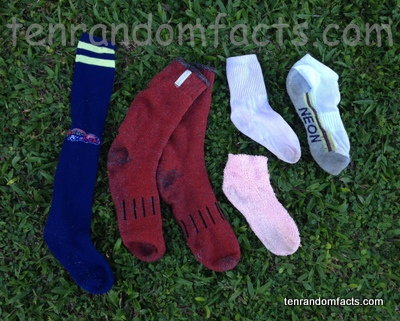Instead of putting socks in someone’s mouth, put some in their brain.
- A sock is a popular article of clothing designed to fit on a human foot, and it is usually sold in a pair, that match in colour and style, so that both feet can be covered by them.
- People wear socks for a number of reasons, including keeping feet warm; absorbing sweat; increasing foot comfort in shoes; and as a fashion accessory; and they are used in sport and hiking to protect the leg area from abrasions.
- The English term ‘sock’ comes from ‘socc’, an Old English term, meaning ‘light shoe’ or ‘slipper’, which originates from ‘soccus’, a Latin word that has an almost identical meaning.
- Socks are found in a wide range of lengths, including foot, ankle, shin and knee lengths, with some reaching the thigh, although these items are generally named ‘stockings’.
- Synthetic and natural fibres are generally used to make socks, including nylon, silk, wool, linen, polyester and cotton, while thousands of years ago, leather or cloth fabric wrapped around one’s feet, or felted animal hair, were used.
- Socks come in a wide variety of colours, and they can be plain, patterned or feature an image, while some are host to protruding ornaments like bows and pompoms, or trimmed with items like decorative lace.
- The use of socks made from felt in Ancient Greece around the 700s BC is evident, and a knitted pair of Egyptian ones have been found that date back to 200 to 500 AD.
- A knitting machine was invented in 1589 by William Lee, an English clergyman, that quickened the production of socks, although the process was not widely adopted until the late 1700s and early 1800s, and eventually machines completely replaced hand knitting.
- A sock is generally a flexible enclosed item with a small opening at the upper end where the foot is inserted, although some versions of the clothing are flat cloth wrapped around the foot, while others have separated toe pockets.
- Between 400 and 1300 AD, socks became a popular accessory and were adopted by many Europeans, especially the wealthy; and in modern times, socks, which are generally machine knitted, have become readily available and inexpensive in the Western world.
Bibliography:
F Nancy, A Brief History of Socks and Hand-knitted Footwear, 1997, Crofters, http://www.crofters.org/personal%20essays/history%20socks.htm
Sock, 2015, Wikipedia, https://en.wikipedia.org/wiki/Sock
Sock History, n.d, Lonely Sock, http://www.lonelysock.com/SockHistory.html







